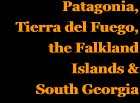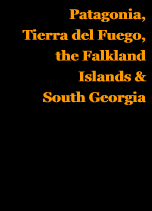 |
 |
 |
|||||||||||||||
 |
|||||||||||||||||
 |
|||||||||||||||||
Chapter 6
The Chiloe Island 60cm gauge railway
Main pages
The Chillan to Las Termas line •
Appendices
3 Analysis of Chilean 60cm gauge locos •
5 Documents from prior to construction •
6 Documents during construction •
7 Documents from later years •
Appendix 16
Memories of a pensioner by Juan Galvez R. – journey in the Chilote train from Ancud to Castro
Through the good offices of my wife, I requested a pair of complementary tickets from the Alameda [the railway station in Santiago for services to the south] to the port of Castro, in the Isla Grande de Chiloé, in other words to the most southerly part of our railway system.
I will try to introduce the benevolent reader to the Lilliputian railway which unites the two ports of Ancud and Castro, in the very beautiful Isla Grande de Chiloé.
After a necessary stay of two days in Ancud, determined by the arrival of the steamer, the hotel, and the departure of the train, I eventually directed my steps, with my wife, towards the little station where the toy train was ready.
The station is a building without pretensions; a small office for the station-master, who at the same time performs the offices of ticket clerk, porter, warehouseman and cashier. With so many jobs to do, he has no time to sit down. There is hardly any furniture, and what little there is is his own. I can well believe that this is Chile's most Spartan station.
However, it does possess a small workshop, which builds passenger coaches of just one class, all that the railway currently has: third class. It is the world's most democratic train, despite the wishes of the President of the Republic that there should be a class for the wealthy and another for the average person who does not want to pay for first class.
There are no coaches for snobs in Chiloé. The train is made up of a microscopic locomotive; everything in Chiloé is small: the people, the trains, the horses; on the other hand, the bills in the hotels are astronomic.
No sooner were we settled in our 'pullman' third class, than the train set off; a hoarse whistle worthy of a 'Mikado' announced it, and the toy train begins to move, with much squealing of metal.
On leaving the station the train climbs for a kilometre or so, in order then to descend towards the estuary of the Río Pudeto. From its windows
can be seen a beautiful bridge of reinforced concrete, built by the public works department. Eleven years ago that bridge did not exist…
The train continues along the Río Pudeto on the one hand; on the other, great forests of araucarias [monkey puzzles]. A great sawmill can be seen, near the mouth of the river into the Pacific Ocean. Now enormous ferns, almost like trees, of a kind not seen in the northern towns, adorn the sides of the track.
Flocks of sheep graze quietly on the islands and along the tributaries of the Río Pudeto; elegant and beautiful pink swans swim peacefully on the quiet waters of this vast river, which only becomes rougher on entering the Pacific.
After twenty minutes travelling we enter the station of Pupelde. A moment's halt and the train restarts to the sonorous voice of the station-mistress, she who, when the line is clear, calls to the guard:
Away you go! Then . . .
We cross a bridge some hundred metres long. I ask my neighbour its name. He answers "mai-mai, peñi…". I scratch my head, not being able to understand what the old man had said, but a bruiser, very blond and ruddy-faced, tells me that the bridge is that of San Antonio and that what the Indian had said to me had meant "Good morning, how are you?"
We continue on, through a splendid forest of muermos and alerces [larches] of enormous height. The muermos in full flower seem like flowery almond trees. Around 10am we arrive at Coquiao, a halt without a station-master, where there joins the train a buxom and beautiful German woman, who is the postmistress. As soon as she is seated the train starts again. The dense forests of muermos continue, whose flowery tops give the impression that they are fleeing the quilares, bushes that pursue them up more than thirty metres. Clumps of cinnamon trees [this is not the cinnamon from which we get our spices], the sacred native tree, can be seen, from time to time, along the track. Crossing a small ridge, we spy the station of Puntra, where we arrive at 11am, time for a lunch break.
The inn at Puntra is a small German chalet, where we were waited on by a friendly 'fraulein' with hair of old gold, blue eyes, and cheeks the colour of the local apples (Please forgive my enthusiasm, reader). Moving on to a more down-to-earth topic, we devoured three succulent Chilote-German dishes, more than enough butter, a nice cup of tea, and all for a bill for two people of $150 local currency. Nowhere in the world, and it's placed on record that I've reached the North Atlantic, have I lunched better or more cheaply than in Puntra, in a delicious setting, situated in the midst of enormous woods of elms and hazels, trees that seem to be burning because of their red and tasty fruit.
The journey continues and we arrive at the station of Putalcura; a name that the railway management decided to alter, after the diabolical people, friends of the calembures [sprites], played pranks. Today it is called Butalcura. The station is situated beside a wooden bridge, somewhat ruinous. Another is being constructed of cement. At this station the minuscule train took water.
Leaving Butalcura, a ravine of 200 metres depth could be seen. A torrent of foaming black water runs along its bed. Huge trees emerge from its depths and their tops reach to the height at which slips along the diminutive train.
At one in the afternoon we arrive at a station with a rather indecent name, Mocopulli. Here there is a station-master and much Chilean mail, however, the leather padlocked mailbags are Spanish, therefore the label says España. Half an hour later we arrive at Piruquina, the station in which is located, I discovered, the farm of Señor Arturo Yungue, a great old islander, who has recently transferred a stretch of land to LAN [the Chilean State Airline] so that they can build an aerodrome. This hacienda [estate] produces enormous quantities of wheat and timber and maintains a fantastic flock of sheep. It covers 1500 hectares… After crossing valleys and hollows, we spot the sea in the distance.
We descend in the little train towards the port of Castro, the end of our journey. There has been such variety and beauty in the landscapes that our journey has seen, that now we understand why it is called the Switzerland of Chile.
Approaching Castro, we see beside the line a limeworks using seashells, named El Rejar, whose products fertilise the soil. We continue skirting the sea, along a clay-covered hillside. These hills constantly block the track, because the rain erodes the soil, dumping it on the rails, It is well-known that Chiloé has thirteen months of rain each year!
Before reaching the station, and very close to there, is found the tragic site where the renowned parliamentarian Guillermo Eyzaguirre Rousse died. A plaque commemorates the event, that in its time saddened the whole country.
It is at two in the afternoon when the train arrives at the most southerly Chilean railway station: Castro. Terminal station of the railway, departmental capital, and an important port as it can cope with large ships.
The station-master of Castro, like his counterpart in Ancud, in addition to his proper title is baggage clerk, warehouseman, shunter, and ticket issuer; that is to say he fills all the roles of an employee under contract. His day begins at 5am, and continues without a break until 9pm. His office, if such it can be called, is a very modest room, and of course seats are conspicuously absent. The goods warehouse is tiny and does not meet the needs of Castro's commerce, where the mean carts with their infernal rattling from their wheels arrive.
Few railways like this one give us time to admire these marvellous regions in all their exuberant splendour. They draw the attention of a traveller, these tall forests, contradicting the popular saying, 'A growing sapling, needs a stake.' Here all the trees grow straight. They grow thus: By reason or force. The clearing of the land which is not yet prohibited, burns large areas of forest, that are then used for cultivated fields: wheat, barley, potatoes; the famous corahilas potatoes, or those called Channel potatoes, they are from this region. The forests seem like an immense battlefield, or cemeteries of enormous black crosses, and when it gets dark they turn into the most fantastic shapes.
Later on, we return to Ancud, very pleased to have seen and admired the exuberant island vegetation, that introduced me to the little railway which unites the two most important towns of the famous Isla Grande de Chiloé.
J. G. R.
Chilean railways tourist newspaper En Viaje, 1953
23-2-2018